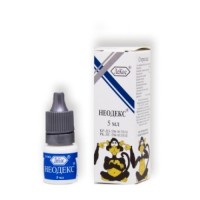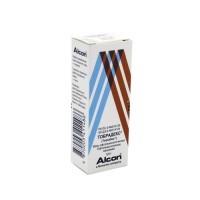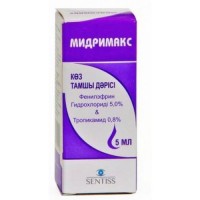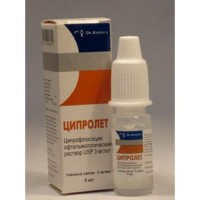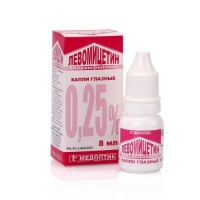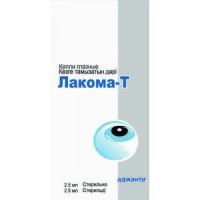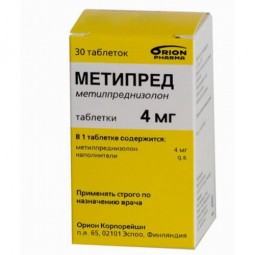The instruction for medical use of DEKSA-GENTAMITsIN medicine the Trade name Deksa-Gentamitsin the International unlicensed name Is not present the Dosage form of the Drop eye Structure One ml of solution contains active agents - sodium dexamethasone phosphate of 1 mg, Gentamycini sulfas of 5 mg, excipients - a benzalkoniya chloride, sodium chloride, potassium dihydrophosphate, potassium hydrophosphate, water for injections. The description Transparent solution from colourless till light yellow color Pharmacotherapeutic group Anti-inflammatory drugs in a combination with antimicrobial drugs. Glyukokortikosteroda in a combination with antimicrobial drugs. Dexamethasone in a combination with antimicrobial drugs. The ATX S01C A01 code the Pharmacological Pharmacokinetics Later properties of topical administration of gentamycin, depending on drawing frequency, in a conjunctiva and a cornea are reached bactericidal concentration. At ophthalmologic use of the phenomena of system absorption of gentamycin it is not expected. Sodium dexamethasone phosphate almost does not get through an intact epithelium, however its absorption considerably increases at inflammation or injury of mucous membranes of an eye. Dexamethasone contacts plasma albumine in the dose-dependent way. Average elimination half-life of dexamethasone at adults makes about 250 minutes of serum (± 80 minutes). Dexamethasone is removed mainly by kidneys in the form of free alcohol derivative. It is exposed to partial metabolism, and dexamethasone metabolites are also removed mainly by kidneys in the form of glyukuronat or sulfates. A pharmacodynamics Deksa-Gentamitsin is the combined drug with antibacterial and anti-inflammatory action for topical administration in ophthalmology. Dexamethasone is the glucocorticosteroid possessing the significant anti-inflammatory, antiallergic and immunosuppressive action. It oppresses emission by eosinophils of inflammatory mediators, migration of mast cells and reduces permeability of capillaries. Gentamycin is a bactericidal antibiotic of a broad spectrum of activity from group of aminoglycosides. Getting through a cellular membrane of bacteria, gentamycin it is irreversible contacts a 30S-subunit of bacterial ribosomes, thereby inhibiting synthesis of bacterial proteins. The sensitivity to gentamycin in general is confirmed for the following strains: - aerobic gram-positive microorganisms: Staphylococcus aureus, Streptococcus spp., Corynebacterium spp., Bacillus spp., - aerobic gram-negative microorganisms: Haemophilus influenzae, Haemophilus parainfluenzae, Enterobacteriaceae (Escherichia coli, Proteus mirabilis, Klebsiella oxytoca), Serratia marescen, Enterobacter cloacae, Klebsiella pneumoniae, Pseudomonas aeruginosa, Acinetobacter Iwoffii, Acinetobacter baumannii, Moraxella catarrhalis. At the same time at infection with some microorganisms the use of gentamycin can be inefficient because of development of resistance. Treat such bacterial strains: - aerobic gram-positive microorganisms: koagulazo-negative strains of Staphylococcus, Streptococcus pneumoniae, Streptococcus spp. (except for the Viridans group) and Enterococcus spp., - aerobic gram-negative microorganisms: Stenotrophomonas maltophilia. The resistance to gentamycin can be mediated by several mechanisms, the most important of which is the enzymatic inactivation which makes impossible linking of an antibiotic with bacterial ribosomes. There is a broad cross resistance of gentamycin with Tobramycinum and partial cross resistance with other antibiotics of group of aminoglycosides. In general the prevalence of the acquired resistance to gentamycin can differ considerably depending on the area and during a course of treatment. Indications - inflammation of a front segment of an eye with the accompanying infectious diseases caused by the bacterial strains sensitive to gentamycin or with risk of developing bacterial infections - the allergic inflammations of a front segment of an eye which are followed by bacterial superinfection the Route of administration and doses On 1 drop of drug dig in in a conjunctival sac of the affected eye of 4-6 times a day. Usually duration of treatment does not exceed 2 weeks. Depending on a clinical picture it is necessary to control periodically efficiency of treatment to establish expediency of continuation or replacement of therapy. When burying eye drops it is necessary to avoid contact of a tip of a dropper with an eye or skin. Side effects - local reactions of hypersensitivity, including passing burning sensation and misting of sight and also contact allergic reactions, such as itching, hypostasis or eczema a century - increase in intraocular pressure (glaucoma), a cataract - an epithelial herpetic keratitis, perforation of a cornea at the available keratitis - fungal infections or exacerbation of bacterial infections of a cornea - a ptosis, a mydriasis - delay of healing of wounds of the Contraindication - hypersensitivity to active agents or auxiliary components of drug - an epithelial herpetic keratitis and other viral diseases of eyes - wound or cankers of a cornea - is closed - or otkrytouglovy glaucoma - tuberculosis of eyes - exclusively bacterial or fungal infections of eyes Medicinal interactions of Special researches of medicinal interactions of drug was not carried out. Simultaneous use of ophthalmologic drugs of glucocorticosteroids with atropine or other anticholinergics can lead to additional increase in intraocular pressure. Gentamycin is not compatible to Amphotericinum B, heparin, Sulfadiazinum, cefalotin and kloksatsilliny. Simultaneous topical administration of gentamycin and one of these substances can cause the sedimentation phenomena in a conjunctival sac. At simultaneous use of eye drops Deksa-Gentamitsin with other drugs for topical ophthalmologic administration it is necessary to maintain a 15-minute interval between burying. The special instructions Drug the benzalkoniya contains chloride which can cause irritation of eyes and decolouration of soft contact lenses. Therefore during drug treatment it is not necessary to carry soft contact lenses. Contact lenses should be removed before use of drug and to repeatedly insert them not earlier, than in 15 minutes after burying. As prolonged use of ophthalmologic drugs of glucocorticosteroids can cause reversible increase in intraocular pressure (glaucoma) or irreversible formation of a cataract, at use of eye drops Deksa-Gentamitsin more than 10 days in a row it is regularly necessary to check the intraocular pressure and a condition of eyes of the patient. In case of development of reactions of hypersensitivity during treatment it is necessary to stop drug use immediately. Pregnancy and the period of a lactation Eye drops Deksa-Gentamitsin should not be applied in the first trimester of pregnancy, and throughout further duration of gestation drug can be used only after careful assessment of advantages of its use to mother and possible risks for a fruit. Drug is not recommended to be used during feeding by a breast. Use in pediatrics the Data on efficiency and safety of use of drug for children and teenagers are absent. Features of influence on ability to run the vehicle or potentially dangerous mechanisms Right after burying drug perhaps short-term misting of sight. Therefore at control of motor transport or work with difficult mechanisms after use of drug it is necessary to wait several minutes before restoration of clearness of sight. Overdose About cases of overdose it was not reported. At appropriate use of drug of the phenomena of overdose or intoxication it is not expected. A form of release and packing On 5 ml of solution of drops eye in the bottles droppers closed by caps with control of the first opening. On 1 bottle dropper together with the instruction for medical use in the state and Russian languages place in a cardboard box. To Store storage conditions in original packing at a temperature not above 25 °C. To store out of children's reach! 3 years not to apply a period of storage after the termination of the expiration date specified on packing. A period of storage after the first opening of packing – 4 weeks. Prescription status According to the prescription of Proizvoditel URSAFARM Artsnaymittel GmbH / URSAPHARM Arzneimittel GmbH Industriyestrasse 35, D-66129 Saarbruecken, Germany (Industriestrasse 35, D-66129 Saarbrucken, Germany) the Owner of the registration certificate of URSAFARM Artsnaymittel GmbH, Germany (URSAPHARM Arzneimittel GmbH, Germany) the Address of the organization accepting in the territory of the Republic of Kazakhstan claims of consumers on quality of products (goods): Almaty, Kunayev St., 18, office 6
to Develop representative office of LLC Sona-Pharm in Almaty, RK
to Develop representative office of LLC Sona-Pharm in Almaty, RK

